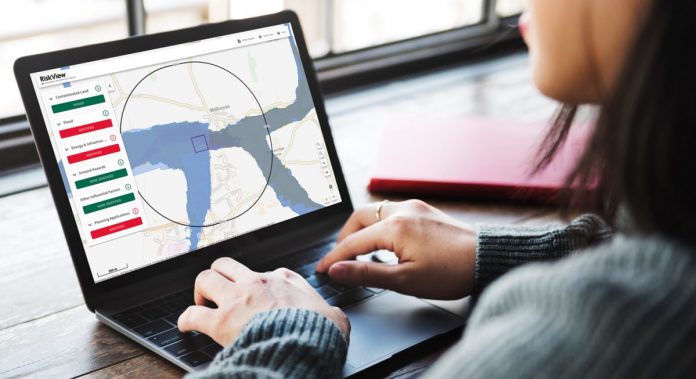Flooding is considered a complex and technical area of environmental risk; however, with the flood data we have available today at our fingertips, it doesn’t have to be
If you are consuming risk information, whether you operate in the public or private sector, the leading requirements are simplicity, accuracy and accessibility. If you are providing risk information, whether that is the raw data, its analysis, interpretation or validation, the leading requirements remain the same.
This perfect union of demand and supply suggest a harmonious relationship between the provision of flood risk data and its common understanding. However, in a burgeoning risk area with increasingly specialist datasets and complex terminology, this is clearly not the reality.
At Landmark, we believe in working towards this reality and making flood risk simple, accurate and accessible for everyone. Whether you are developing, valuing, transacting or managing land and property, our specialist and unique services can help you understand flood risk.
Content is king
The provision of flood data has long been in a race; trying to keep pace with our increasing technical understanding. In 2001, the main sources of risk were considered to be only river and coastal events.
By 2009, surface water risk had been introduced to our collective understanding, with groundwater risk following shortly thereafter. Each of the four sources of flood risk now has its own specialist data providers and experts, spanning both the public and private sector.
A brief look at just one of these risk types – surface water – highlights this growing complexity. Risks are reported within four categories across three return periods, thus serving up nine possible data categories for consideration. When including the rest (river, coastal and groundwater), as well as the numerous different data providers, this amounts to a very large pile of data. A pile so big it’s easy to get lost in.
Envirocheck Analysis is our unique data viewer that reduces the likelihood of getting lost in this data pile. Our market leading flood data report, Environcheck Flood Screening, is provided as both a pdf report and an online viewer. This has allowed us to deliver on all three data principals:
- Simple: We review every available dataset and only include those of relevance and value.
- Accurate: Every dataset used within our reports is analysed and validated by our data experts.
- Accessible: Our viewer provides customers an ability to analyse, overlay and interrogate their data.
If content is king then context is god
No matter how good the data, it will only become usable information once context and interpretation are applied. This only comes from a human being – and the higher qualified and commercially pragmatic, the better.
In the UK, where the number of specific datasets available on any given property could be upwards of 25, the importance of pragmatism is paramount.
Landmark’s in-house consultancy team, Argyll Environmental, is both highly qualified and commercially pragmatic. With the combined experience from providing >10,000 risk opinions per month in the conveyancing sector, the team is uniquely placed to refine their risk tolerance and deliver the most pragmatic approach possible to reviewing risk.
This approach is informed and governed by industry-specific accreditations with the Institute of Environmental Management & Assessment and the Chartered Institute of Water & Environmental Management.
RiskView reports (RiskView Residential and RiskView Commercial) are designed to open the door to this critical stage of data interpretation for the very first time within the conveyancing sector.
These reports are still delivered in the traditional method of pdf reports for property files; however, they have the added benefit of the online data viewer referenced above. This is a window into the logic and decision making of our in-house consultancy team.
By providing this transparent access, we are fuelling a closer alignment of stakeholders involved in any project. No longer is the risk opinion clouded by jargon and hidden behind static paper-based data, not accessible or useable by the actual customer. We are now held to account, as the tools we use to configure our risk opinion are also the tools available to everyone involved in the transaction to understand it.
Content, context and consultancy
Even with the best available flood data and the most highly qualified and pragmatic opinion, this doesn’t always guarantee complete risk resolution. There will be times where further, more bespoke analysis is required on a site to reduce or manage identified flood risks.
This bespoke analysis is also mandatory in certain redevelopment scenarios, for example, sensitive land uses proposed in high risk areas (eg residential development in Flood Zones 2 and 3).
Consultancy services are provided by our in-house consultancy team, allowing a seamless transition through all the possible stages of a flood risk project. We don’t just supply market-leading data or apply experienced risk opinions; we also deliver any bespoke flood risk assessment required to support a development proposal.
Flood risk assessments in support of redevelopment are set in the context of a changing climate. We are working at the forefront of understanding the impact a changing climate can have on flood risk.
We are soon to launch the first full GB flood dataset based on UKCP09 Climate Change Projection Scenario (UKCP09). This will, for the first time, allow customers to adapt property management strategies in light of future risk forecasting.
Developed in partnership with flood modelling experts Ambiental and with development insight from Wales & West Utilities, this has already received exceptionally positive responses from Defra, DECC and the Climate Change Committee.
Conclusion
So whether it’s future forecasting or the ‘here and now’, and whether you require data, risk opinion reports or bespoke services, help is available. Flooding is a complex and technical area of environmental risk. It really shouldn’t be.
For more information telephone 0844 844 9966, visit www.landmark.co.uk or follow the team on Twitter @LandmarkUK.
Useful links:
www.landmark.co.uk/landmark-legal/riskview-conveyancer
Chris Loaring
Head of Consultancy
Landmark Information
Tel: 0844 844 9966
Twitter: @LandmarkUK
Please note: this is a commercial profile.














